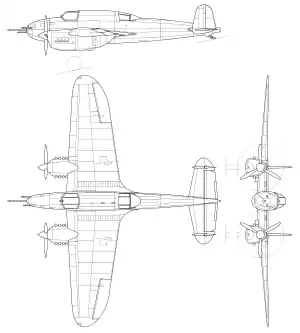PZL.38 Wilk
The PZL.38 Wilk (wolf) (PZL-38) was a Polish fighter-bomber developed and manufactured by PZL state factory in 1937.
| PZL.38 Wilk | |
|---|---|
 | |
| PZL.38 | |
| Role | Fighter-bomber aircraft |
| Manufacturer | Państwowe Zakłady Lotnicze |
| First flight | 1938 |
| Number built | 2 |
| Variants | PZL.48 Lampart |
Design and development
In 1934 the Polish Air Force ordered a new multi-role heavy fighter-bomber. It was initially supposed to replace fighters in both pursuit and escort duties and light bombers (a popular idea at the time, which resulted in aircraft like the Bf 110). In an internal PZL competition a design of the engineer Franciszek Misztal won and was given the designation PZL.38 Wilk. Its construction used the diminished aerodynamic profile and configuration from the PZL.37 Łoś medium bomber. The powerplant was to be the 490-hp PZL Foka (seal) light-weight V-engine, designed by Stanisław Nowkuński of Polish Skoda Works (then PZL WS-1). Unfortunately, Nowkuński died in the Tatry mountains on 30 July 1936, and work on the engine slowed. Due to technical problems, overheating and vibration, it was decided to use a foreign engine.
In 1937 two prototypes of PZL.38 were built. The second one (PZl.38/II) received the American Ranger SGV-770B engines (420-450 hp), which were less powerful than the PZL "Foka" engine. As a result, the prototype didn't meet expected performance. The second prototype flew first in April or May 1936. The first prototype PZl.38/I, received the PZL Foka engine. The airplane was shown in 1938 at the Paris Air Show. It was flown only in February or March 1939 and also did not meet expected performance (estimated maximum speed was 520 km/h, while it hardly reached 465 km/h). It was also too heavy (2155 kg instead of 1715 kg) and had too small useful load. Because of these facts, further development of PZL.38 "Wilk" aircraft and "Foka" engine was abandoned in the Spring of 1939, in a favour of the new construction PZL.48 "Lampart" - which was a modification of "Wilk" with radial engines.
Description
It was a twin-engine low-wing cantilever monoplane of metal construction, metal covered. The fuselage was semi-monocoque, elliptic in cross-section. The crew of two - pilot and rear gunner/bombardier/observer sat under separate canopies, far from each other, fitted with dual controls. A canopy of pilot's cockpit opened aside. Three part wing, outer parts were built around light closed profiles. Wings fitted with slats and split flaps. Twin vertical stabilizers. Engines in underwing nacelles. Retractable landing gear, with main wheels retracting into engine nacelles, and a rear skid. Three-blade variable (P.38/I) or two-blade fixed propellers (PZL.38/II). Fuel tanks in wings - 500 l. Armament: fixed 20 mm FK-A gun (planned) and two 7.92 mm PWU wz.36 machine guns in the fuselage nose, twin 7.92 mm PWU wz.37 machine gun of a rear gunner, hiding in the fuselage. It could carry one 300-kg bomb.
Operational history
After the German invasion of Poland, both prototypes were not able to fly and remained in factory at Okęcie in Warsaw. They were captured by the Germans in a damaged state, their further fate is not known.
Specifications

General characteristics
- Crew: 2, pilot, rear gunner/bombardier
- Length: 8.35 m (27 ft 5 in)
- Wingspan: 11.05 m (36 ft 3 in)
- Height: 2.50 m (8 ft 2 in)
- Wing area: 20.4 m2 (220 sq ft)
- Empty weight: 2,155 kg (4,751 lb)
- Gross weight: 2,800 kg (6,173 lb)
- Powerplant: 2 × PZL Foka air-cooled 8-cylinder V-engine, 370 kW (490 hp) each
- Propellers: 2-bladed
Performance
- Maximum speed: 465 km/h (289 mph, 251 kn) estimated 520 km/h
- Stall speed: 120 km/h (75 mph, 65 kn)
- Range: 850 km (530 mi, 460 nmi)
- Service ceiling: 9,000 m (30,000 ft) estimated
- Rate of climb: 8 m/s (1,600 ft/min) estimated
- Wing loading: 137 kg/m2 (28 lb/sq ft)
Armament
- 1 x 20 mm FK-A cannon fixed in nose
- 2 x 7.92 mm PWU wz.36 machine guns fixed in nose
- 2 x 7.92 mm PWU wz.37 machine guns movable at the upper rear
- 300 kg bombs
See also
Related development
Aircraft of comparable role, configuration, and era
- Messerschmitt Bf 110, Focke-Wulf Fw 57, Henschel Hs 124
- Potez 63, Breguet 690
- Fokker G.I
- Kawasaki Ki-45
References
- Glass, Andrzej. Polskie Konstrukcje Lotnicze 1893-1939 (Polish aviation constructions 1893-1939). Warsawa, Poland: WKiŁ, 1977. (Polish language, no ISBN)
- Glass, Andrzej. PZL 38 Wilk. Warsawa, Poland: Wydawnictwo Militaria, 1995. ISBN 83-86209-41-0. (Polish language)
External links
| Wikimedia Commons has media related to PZL.38 Wilk. |
- PZL.38 translated description, photos and drawings at Ugolok Neba
